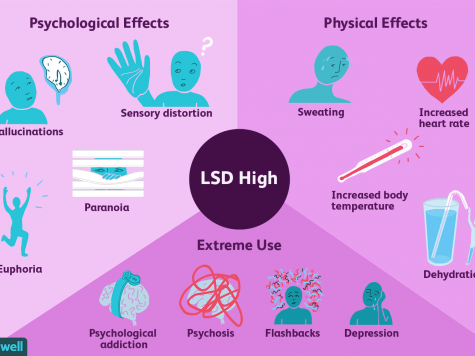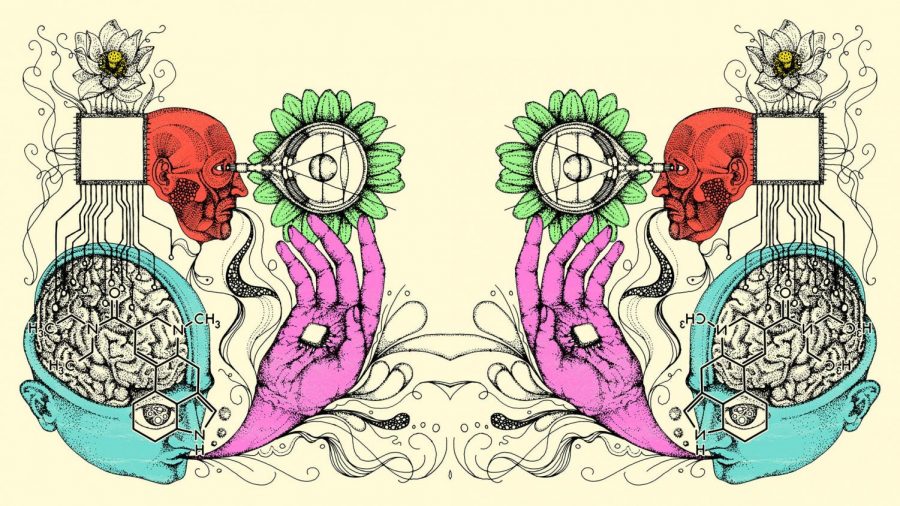The Effects of LSD on the Brain
Lysergic acid diethylamide, commonly known as acid, causes those who ingest the drug to be in a state of hallucination. A seventeen-year-old by the name of Mark underwent a bad reaction to the drug and found himself the next morning in the hospital as well as a charge of public indecency. After Mark tried acid with his friends he decided to go into town, he finally felt the effects, and reacted in the worst way possible. He stopped by a friend’s house near the town to collect himself but the effects increased, and the friends had to barricade him in a room. Mark, agitated, broke a window, jumped out, and took off all his clothes. How does a chemical found in a fungus cause someone to lose their minds?
 In the 1940’s, many people working with an ergot fungus reported feeling bizarre after the fact. Albert Hoffman injected himself with this fungus and on his bike ride home, began hallucinating. He accused his neighbor of being a witch and thought a demon had taken over his body. The morning after, Hoffman felt rejuvenated and devoted his career to studying psychedelics. Acid later became used to treat people with anxiety and depression as well as used in different experiments. One experiment, in particular, was with an elephant by the name of Tusks, a circus elephant who was given an absurd amount of LSD. The elephant lost his mind. Many tried to calm Tusks down, but he died in the process. LSD is a very powerful drug that only a milligram can cause an effect.
In the 1940’s, many people working with an ergot fungus reported feeling bizarre after the fact. Albert Hoffman injected himself with this fungus and on his bike ride home, began hallucinating. He accused his neighbor of being a witch and thought a demon had taken over his body. The morning after, Hoffman felt rejuvenated and devoted his career to studying psychedelics. Acid later became used to treat people with anxiety and depression as well as used in different experiments. One experiment, in particular, was with an elephant by the name of Tusks, a circus elephant who was given an absurd amount of LSD. The elephant lost his mind. Many tried to calm Tusks down, but he died in the process. LSD is a very powerful drug that only a milligram can cause an effect.
LSD affects dopamine, adrenergic, but most importantly, serotonin receptors. Acid has a similar chemical structure as serotonin, the natural happy hormone in the body. Lysergic acid diethylamide goes to 5ht2, the receptor responsible for hallucinations, at an unusual angle. The serotonin receptor folds over the LSD trying to break it down and degrade it. However, this process takes some time, and in the meantime, the LSD produces serotonin, causing a high.
The drug manipulates the part of the brain that controls vision, creating optical hallucinations such as kaleidoscopic view as well as time seeming to slow. It confuses the brain, and usually, when the brain is confused, it tries to make patterns out of the information it’s receiving.
 The drug also lowers blood pressure. As a result, the brain does not function normally and cannot decipher reality from fiction. Those who take acid morph images of surroundings such as rocks into fiction.
The drug also lowers blood pressure. As a result, the brain does not function normally and cannot decipher reality from fiction. Those who take acid morph images of surroundings such as rocks into fiction.
LSD is not meant to be glorified: it is an extremely strong drug and there are few studies of how the drug actually works or any long-term effects. The drug has been known to cause paranoia and panic attacks, a scary state that if taken, cannot just simply get out of. Mark is just one of many examples of what could go wrong with a small amount of LSD.

Sarita Manocha, a senior, has found a passion for writing throughout her years at Keystone. In Keynote Sarita spreads awareness and brings to attention...

